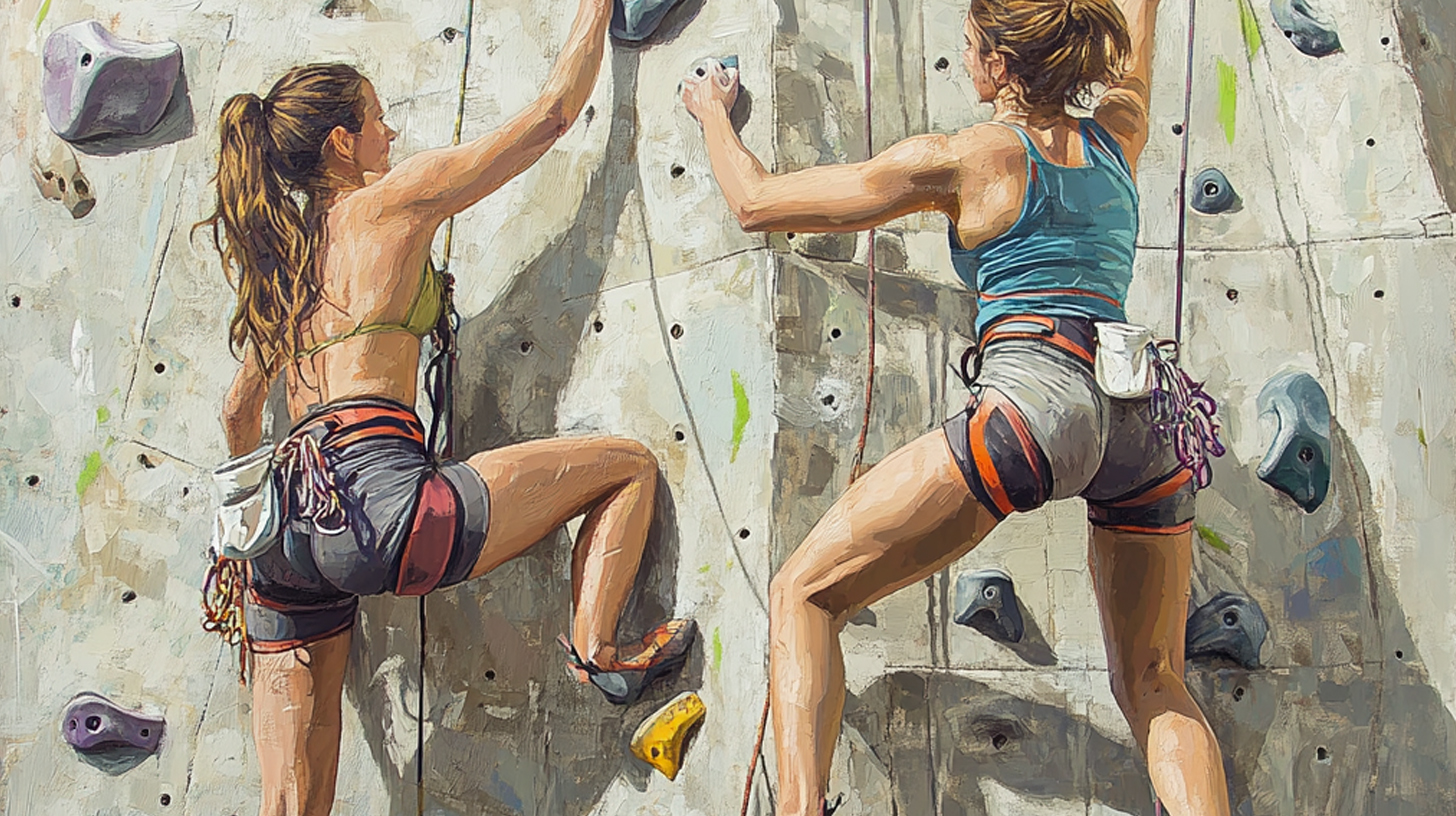Rock climbing is an exhilarating sport that combines physical strength, mental focus, and a love for the great outdoors. For those new to the world of climbing, understanding the basics can make your first experience both safe and enjoyable. Beginner rock climbing is not just about scaling heights; it’s about learning techniques, understanding equipment, and building confidence.
An essential part of any intro to climbing is familiarizing yourself with the gear. A harness, climbing shoes, chalk bag, and helmet are standard pieces that every climber should have. Each piece serves a specific purpose: the harness keeps you secure while on the wall; climbing shoes provide grip and support; chalk helps keep your hands dry for better holds; and a helmet protects against potential falls or debris.
New climber tips often emphasize starting with indoor climbing gyms before heading outdoors. These controlled environments offer routes of varying difficulty levels, allowing beginners to practice safely under supervision. Learning basic skills such as belaying—managing the rope for another climber—and knot tying are crucial steps in becoming a proficient climber.
Finally, understanding body positioning and balance will help you climb more efficiently. Instead of relying solely on upper body strength, use your legs to push yourself upward while maintaining three points of contact on the wall at all times.
By grasping these fundamental concepts in rock climbing basics, new climbers can embark on their journey with confidence and enthusiasm. As you progress from novice to experienced climber, remember that patience and practice are key components in mastering this exciting sport.
The Essential Gear for Beginner Rock Climbers
Embarking on the exhilarating journey of rock climbing requires more than just enthusiasm; it demands the right equipment to ensure both safety and performance. For those new to the sport, understanding climbing gear essentials is crucial. The cornerstone of any rock climber’s kit begins with selecting the right rock climbing shoes. These specialized shoes provide the grip and support needed to tackle various surfaces, allowing climbers to confidently navigate their ascent.
Next on the list is a harness, an indispensable piece of beginner climbing equipment that ensures safety while scaling heights. Harnesses for newbies are designed with comfort and ease of use in mind, featuring adjustable straps to fit securely around the waist and legs. This provides peace of mind, enabling beginners to focus on developing their skills without worrying about their safety.
In addition to shoes and harnesses, other essential items include a belay device for controlled descents and a chalk bag to keep hands dry for better grip. As you start your climbing journey, investing in these key pieces will not only enhance your experience but also lay a solid foundation for your growth in this thrilling sport.
Understanding Different Types of Rock Climbing
Rock climbing is a diverse and exhilarating sport that offers various styles to suit different preferences and skill levels. Understanding the distinctions between these types can enhance your climbing experience and help you choose the best fit for your interests.
Bouldering vs. Top Rope: Bouldering involves climbing shorter routes without the use of ropes, typically on walls that are 10-15 feet high. It emphasizes power and technique, as climbers must navigate challenging moves in a short span. In contrast, top rope climbing involves using a harness attached to a rope that runs through an anchor at the top of the climb, providing security as you ascend taller walls. This style is ideal for beginners due to its safety features and allows climbers to focus on developing their skills without the fear of falling far.
Indoor vs. Outdoor Climbing: Indoor climbing takes place in gyms equipped with artificial walls designed to simulate natural rock formations. It’s accessible year-round regardless of weather conditions and offers varied routes tailored for all levels. Outdoor climbing, however, provides an authentic experience on natural rock faces with varying terrains such as cliffs or mountainsides. While outdoor climbing can be more unpredictable due to environmental factors, it offers unparalleled scenery and adventure.
Sport Climbing Basics: Sport climbing is another popular style where climbers use pre-placed anchors fixed into the rock for protection as they ascend routes ranging from moderate to highly challenging difficulties. This type of climbing requires not only physical strength but also strategic planning to efficiently clip into anchors while maintaining momentum.
By exploring these different types of rock climbing—bouldering vs. top rope, indoor vs. outdoor settings, and sport climbing basics—you can find your niche within this thrilling sport and enjoy its many benefits safely and confidently.
Safety First: Important Safety Tips for Beginner Climbers
Embarking on the thrilling adventure of rock climbing is an exciting journey, but it’s crucial to prioritize safety from the very start. For beginner climbers, understanding and implementing essential safety measures can make all the difference in ensuring a safe and enjoyable experience.
First and foremost, familiarize yourself with basic rock climbing safety tips. This includes understanding the importance of communication with your climbing partner and ensuring that you are always aware of your surroundings. Before you even begin your ascent, take time to thoroughly inspect your safety gear. Safety gear checks are vital; ensure that harnesses fit snugly, helmets are secure, and ropes are free from any damage or wear.
Belaying 101 is another critical component for beginners to grasp early on. Proper belaying techniques not only protect you but also safeguard your climbing partner. Make sure to practice these techniques under supervision until you’re confident in managing the rope effectively.
Lastly, always adhere to beginner precautions in climbing by starting with routes that match your skill level. Avoid overestimating your abilities as this can lead to unnecessary risks. By taking these steps seriously and respecting the fundamentals of rock climbing safety, you’ll set a solid foundation for many successful climbs ahead.
The Best Indoor Climbing Gyms for Beginners Near You
If you’re considering starting indoor rock climbing, you’re in for an exciting journey filled with both physical challenges and rewarding accomplishments. Finding the right local climbing gyms for beginners is crucial to ensuring a positive and supportive start. Fortunately, many gyms are dedicated to helping newcomers learn the ropes—literally!
When searching for the best places to learn rock climbing indoors, look for facilities that offer beginner-friendly routes and comprehensive introductory courses. Many gyms provide equipment rentals, so you can try out different types of gear before making any purchases. Additionally, look for gyms with knowledgeable staff who can guide you through your first climbs and teach you essential safety techniques.
Some of the top-rated local climbing gyms often host beginner nights or workshops, offering a welcoming environment where newcomers can meet fellow climbers and gain confidence on the walls. These sessions usually cover basic skills such as belaying, knot tying, and understanding climbing grades.
Remember that each gym has its own unique atmosphere, so it’s worth visiting a few to find one where you feel comfortable and inspired to climb regularly. With the right support system in place at your chosen gym, you’ll be scaling new heights in no time!
Your First Climb: Techniques and Tips to Succeed on Your First Wall
Embarking on your first climb can be both exhilarating and daunting. However, with the right techniques and strategies, you’ll find yourself scaling that wall with confidence. For beginners in bouldering, understanding the basics can make all the difference.
Start by familiarizing yourself with essential bouldering techniques for beginners. Focus on footwork; precise placement of your feet is crucial as it provides stability and balance. Practice using the edges of your shoes to grip holds effectively, which will help conserve energy for more challenging sections.
Grip strength is another vital component. Try different handholds to understand how each affects your climbing style. Open-handed grips are often less strenuous than crimping, so experiment to find what feels most comfortable and secure for you.
When it comes to first-time climb advice, remember that pacing is key. Rushing through a route can lead to fatigue or mistakes—take your time to plan each move carefully before executing it. Visualize your path up the wall and anticipate potential challenges ahead.
Conquering your first wall requires both mental and physical preparation. Stay relaxed and breathe steadily; maintaining a calm mindset will enhance focus and decision-making during climbs. Additionally, don’t hesitate to seek guidance from more experienced climbers or instructors who can offer valuable insights tailored specifically for beginners.
By incorporating these strategies into your practice sessions, you’ll build a strong foundation that will not only help you succeed on your first wall but also foster long-term growth in this rewarding sport.
The Challenge and Enjoy Your Rock Climbing Journey!
As you reach the end of your rock climbing journey, it’s important to reflect on both the challenges and the joys that this exhilarating sport brings. Rock climbing is not merely about reaching the summit; it’s a multifaceted experience that tests your physical limits, sharpens your mental focus, and offers a profound connection with nature.
The challenges you encounter along the way—whether they are technical routes, fear of heights, or building endurance—are integral parts of the journey. Each obstacle presents an opportunity for growth and learning. Embrace these difficulties as they come; they are what make each climb unique and rewarding.
Equally important is to savor every moment of enjoyment that rock climbing provides. The thrill of conquering a difficult route, the camaraderie shared with fellow climbers, and the breathtaking views from atop a cliff are rewards in themselves. These experiences enrich your journey and leave lasting memories.
In conclusion, whether you’re scaling indoor walls or tackling outdoor crags, remember that every climb is an adventure waiting to be embraced. So gear up, stay safe, challenge yourself wisely—and most importantly—enjoy every step of your rock climbing journey!




